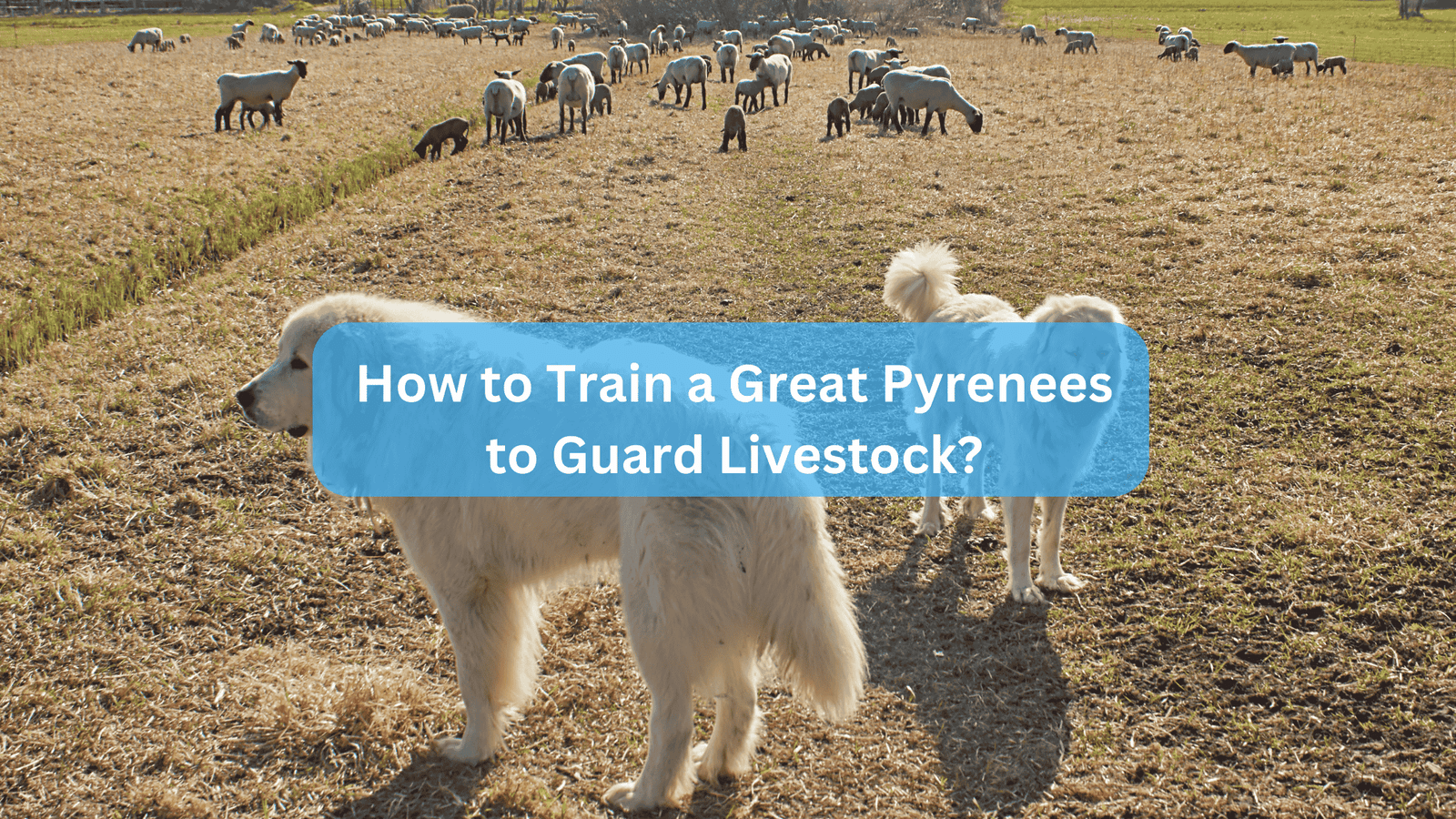How to Train a Great Pyrenees to Guard Livestock? – Training a Great Pyrenees to guard livestock is a rewarding endeavor that requires patience, understanding of the breed’s unique characteristics, and a structured approach.
Known for their protective instincts and gentle demeanor, Great Pyrenees are one of the most effective breeds for guarding sheep, goats, and other livestock.
This comprehensive guide will cover everything you need to know about training your Great Pyrenees to be an effective livestock guardian.
Understanding the Great Pyrenees
The Great Pyrenees is a large breed with a strong instinct to protect their flock. They are known for their:
- Gentle Nature: Despite their size, they are typically gentle with livestock and children.
- Strong Guarding Instincts: They have a natural tendency to guard against predators such as coyotes and wolves.
- Independence: This breed is known for being independent thinkers, which can be both an asset and a challenge in training.
Understanding these traits is crucial in developing an effective training strategy.
Preparing for Training the Great Pyrenees
Before you begin training your Great Pyrenees, consider the following preparations:
- Establish Your Goals: Define what you want your dog to achieve. This could include protecting specific types of livestock or responding to certain commands.
- Create a Safe Environment: Ensure that your training area is safe for both your dog and the livestock. This includes secure fencing and supervision during initial interactions.
- Gather Training Tools: You may need treats, leashes, and toys to facilitate training sessions.
How to Train a Great Pyrenees to Guard Livestock – Step-by-Step Training Process
1. Socialization with Livestock
Introducing your Great Pyrenees to livestock is the first step in training. Follow these guidelines:
- Start Young: Ideally, begin socialization when your dog is a puppy (8-12 weeks old). This allows them to bond with the livestock early on.
- Controlled Introductions: Start by introducing your puppy to calm, mature animals in a controlled environment. Use a leash initially to maintain control.
- Supervised Interaction: Allow your puppy to observe and interact with the livestock while you supervise closely. Encourage gentle behavior and discourage any chasing or rough play.
2. Building Trust
Trust between your Great Pyrenees and the livestock is essential for effective guarding:
- Positive Reinforcement: Reward your dog with treats and praise for calm behavior around the livestock.
- Modeling Behavior: If possible, introduce your puppy to an older, trained Great Pyrenees who can model appropriate behavior around the livestock.
3. Establishing Territory
Great Pyrenees need to understand their territory:
- Define Boundaries: Walk your dog around the perimeter of the area where they will be guarding livestock. This helps them understand their space.
- Regular Patrols: Encourage your dog to patrol this area regularly. Use commands like “patrol” or “check” to reinforce this behavior.
4. Teaching Commands
Commands are crucial for effective communication during training:
- Basic Commands: Teach basic commands such as “sit,” “stay,” and “come.” These commands form the foundation of more advanced training.
- Specific Guarding Commands: Develop specific commands related to guarding behaviors, such as “leave it” for distracting them from chasing non-threatening animals or “alert” for notifying you of potential threats.
5. Gradual Independence
Once your dog is comfortable around livestock, begin allowing them more independence:
- Short Alone Time: Start by leaving your puppy alone with the livestock for short periods (a few minutes) while you observe from a distance.
- Increase Duration Gradually: As your dog becomes more confident, gradually increase the time they spend alone with the livestock.
6. Addressing Behavioral Issues
Behavioral issues may arise during training:
- Discourage Chasing: If your puppy chases livestock or other animals, use commands like “no” or “leave it” immediately followed by redirection towards appropriate behavior.
- Correct Aggression Towards Other Animals: If aggression towards other animals occurs, ensure proper socialization with those animals outside of guarding duties.
Common Challenges in Training a Great Pyrenees
Training a Great Pyrenees can come with its challenges:
- Independence: Their independent nature may lead them to make decisions without waiting for commands. Consistent reinforcement of commands is key.
- Distraction by Wildlife: They may be distracted by wildlife or other animals. Reinforcing recall commands can help manage this behavior.
Maintenance of Training a Great Pyrenees
Once basic training is established, ongoing maintenance is essential:
- Regular Practice Sessions: Continue practicing commands and reinforcing positive behaviors regularly throughout their lives.
- Exposure to Different Situations: Expose your dog to various environments and situations involving livestock to ensure they remain adaptable and responsive.
Frequently Asked Questions (FAQs)
What age should I start training my Great Pyrenees?
Start socialization as early as 8 weeks old. Early exposure helps them bond with livestock effectively.
Can I train an adult Great Pyrenees?
While it’s more challenging, adult dogs can still learn if they have not been exposed to livestock before. Patience and consistent training are essential.
How long does it take to train a Great Pyrenees?
Training duration varies but expect several months of consistent effort before achieving reliable guarding behavior.
What if my dog shows anxiety around livestock?
If your dog appears anxious, take it slow. Gradually increase exposure while providing reassurance and positive reinforcement.
Also Read: Dinuguan for Dogs: A Comprehensive Guide
Also Read: Premack Principle in Dog Training – Best Guide
Conclusion
Training a Great Pyrenees to guard livestock requires dedication, patience, and an understanding of their unique traits.
By following these structured steps—from socialization and trust-building to teaching commands and addressing behavioral challenges—you can develop a reliable guardian for your farm or homestead.
Remember that consistency is key; regular practice will help reinforce good behaviors and ensure that your Great Pyrenees remains an effective protector of your livestock for years to come.
Sources:







